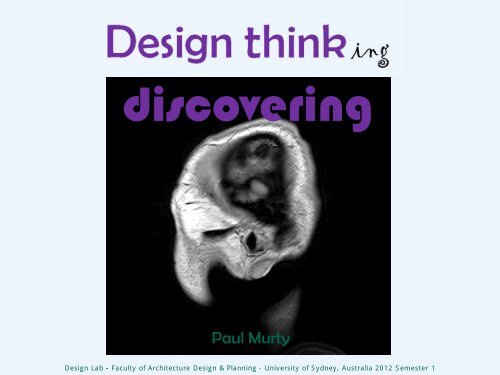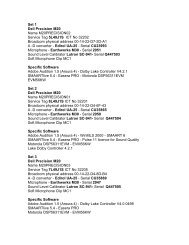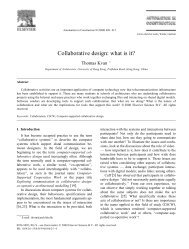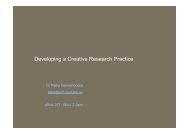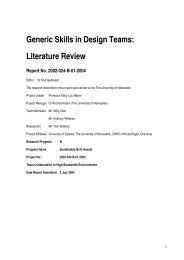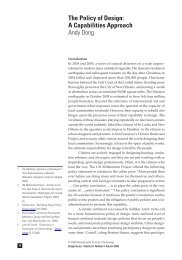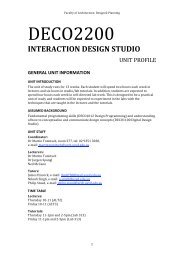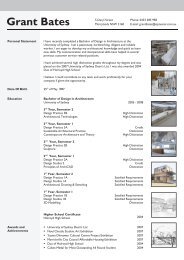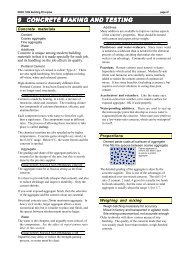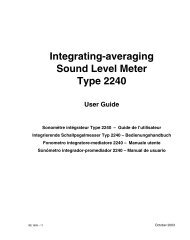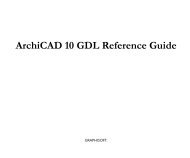Discovering
Discovering
Discovering
- No tags were found...
You also want an ePaper? Increase the reach of your titles
YUMPU automatically turns print PDFs into web optimized ePapers that Google loves.
Going beyond the evidenceLike medieval philosopher Maimonides, Brunerregards the perfection of the intellect as thehighest human achievement.Regarding discovery, Bruner adds:the most personal of all that one knows isknowledge discovered for oneself.The benefits from self discovery include:1. Increase in intellectual potency2. Shift from extrinsic to intrinsic rewards3. Learning heuristics of discovery4. Aid to conserving memoryBruner (1979) On Knowing – Essays for the left handMaimonides (1190) Guide for the PerplexedSee also: http://plato.stanford.edu/entries/maimonides/Tee shirt image from: zazzle.comidea9106 - design thinking – week 10 - discoveringDiscoveryCognitive scientist and educator, Jerome Bruner, describesdiscovery as:… rearranging or transforming evidence in such a way that one is enabledto go beyond the evidence, so reassembled, to new insightsDesign Lab - Faculty of Architecture Design & Planning - University of Sydney, Australia 2012 Semester 1
idea9106 - design thinking – week 10 - discoveringDiscoveryAttributes associated with discoveryIn a study of schoolchildren, aged 10 - 12, Bruner (1979) identified acognitive activity ranging between two approaches, which he described ascumulative constructionism and episodic empiricism• Experiment was in the form of a 20 questions game• Children were required to discover the cause of a car accident byasking questions that can be answered by "yes" or "no".Bruner found that he could identify the alternative approaches from twotypes of questions asked:• Questions to locate constraints - Give shape to an hypothesis;• Hypothesis as question - Questioners he described as potshotters,strung out hypotheses, non-cumulatively, one after the other.Bruner (1979) On Knowing – Essays for the left handDesign Lab - Faculty of Architecture Design & Planning - University of Sydney, Australia 2012 Semester 1
idea9106 - design thinking – week 10 - discoveringDiscoveryAttributes associated with discovery 2The different approaches to questioning were found to beassociated with later use of information and persistence.• In general, children who employed constraint location querying, beforeforming hypotheses, (cumulative constructionists) were more organizedin their harvesting of information and were more persistent.• The potshotters (episodic empiricists) were more likely to ignore, oreven go against, information previously obtained and then becomeconfused and discouraged.I think this is an interesting finding:1. It reminds me of the experiments Lawson did with science andarchitecture students.2. The constraint location children resemble problem focused (science)students and the potshotters sound like solution focused designers.Design Lab - Faculty of Architecture Design & Planning - University of Sydney, Australia 2012 Semester 1
idea9106 - design thinking – week 10 - discoveringDiscoveryAttributes associated with discovery 3To resolve this possible discovery, the following factorsneed to be acknowledged and considered first:1. Design focus analogy appears to be valid. Designers areknown to use conjectural strategies, combined with testing2. Quality of attention - it is possible that childhood potshottingcould become more skilled with practice and increasedknowledge3. Interest in participating in the experiment - The episodicempiricist (ie. potshotter) aimless behaviour could indicatedisinterest in the experiment.This is speculation on my part, but we could look further byexamining the reported experiences of professional designers.Let me remind you of models of discovery and designing, first.Design Lab - Faculty of Architecture Design & Planning - University of Sydney, Australia 2012 Semester 1
idea9106 - design thinking – week 10 - discoveringModels of discoveryDiscovery is also associated with creativitySince 19 th century there have been competing views of creativity(See also week 6 Investigation, Influential research )First half 20 th century – modern era• Behaviorist view - no need to consider processes• Gestalt view - insights needed for novel problemsSecond half 20 th century – cognitive eraCognition viewed as computational - two alternative views• Memory view – don’t distinguish creative from routine cognitive processes• Productive thinking - Gestalt theorists associate insight with restructuringDesign Lab - Faculty of Architecture Design & Planning - University of Sydney, Australia 2012 Semester 1
idea9106 - design thinking – week 10 - discoveringModels of discoveryMemory view of Creative CognitionResearchers Finke, Ward & Smith (1992) studied creativity byfocusing on types of cognitive processes and structures that arelikely to be important in creative thinkingIn their Geneplore model (also mentioned in Week 8 Exploring)• Pre-inventive mental structures, such as conjectured ideas, concepts,or sketches are used in creative search and exploration to internallyrepresent novel patterns, forms and other constructs• Any, of many possible processes may interact, leading to insights andinnovations, or to commonplace cognitions of no further interest• Two classes of process, are distinguished: generative and exploratorySee: Finke, Ward & Smith (1992) Creative CognitionFinke (1995) Creative Insight and Preinventive FormsDesign Lab - Faculty of Architecture Design & Planning - University of Sydney, Australia 2012 Semester 1
idea9106 - design thinking – week 10 - discoveringModels of discoveryMemory view of Creative Cognition 2Generative cognitive processes• Memory retrieval - of existing structures• Association - Formation of associations among these structures• Mental synthesis - of component parts• Mental transformation - Parts and forms can be mentally rearranged andreassembled, rotated or altered in shape to make interesting and potentiallyuseful structures.• Analogical transfer - A relationship or set of relationships in one contextmay be transferred to another• Categorical reduction - Objects or elements may be mentally reduced tomore primitive (or generic) categorical descriptions, enabling them tofunction more broadly as a preinventive structure.Explorative cognitive processes are described in Week 8 ExploringThey include: attribute finding, conceptual interpretation, functional inference,contextual shifting, hypothesis testing and searching for limitations.See also: Finke, Ward & Smith (1992) Creative Cognition and Finke (1995) Creative Insight and Preinventive FormsDesign Lab - Faculty of Architecture Design & Planning - University of Sydney, Australia 2012 Semester 1
Neutral - 3 process viewidea9106 - design thinking – week 10 - discoveringModels of discoveryResearchers Sternberg andDavidson identified 3 mentalabilities or processes that,separately or together, appear tobe required in solving insightproblems.The theory was the outcome ofcuriosity about puzzles, or problemsrequiring flashes of insight or leapsof logic, rather than prior knowledgeMake the fish swim to the right by moving 3 matches.See: Sternberg, R.J. and Davidson, J. (1982)The mind of the puzzler. Psychology Today, 16, 37-44.Image from: smart-kit.comDesign Lab - Faculty of Architecture Design & Planning - University of Sydney, Australia 2012 Semester 1
Neutral - 3 process view 2The 3 processes are:idea9106 - design thinking – week 10 - discoveringModels of discovery1. Selective encoding - selecting and “encoding” information.Understanding which information is relevant to solving a problem, andhow it is relevant.2. Selective combination - combining different and seeminglyunrelated bits of useful information.As with selective encoding the necessary elements of the solution areavailable and visible. The insight may be associated with recognisinga potential for, or a manner of, combination.3. Selective comparison - comparing the problem under withproblems previously encountered and recognise the analogyof another.See: Sternberg, R.J. and Davidson, J. (1982) The mind of the puzzler. Psychology Today, 16, 37-44.Design Lab - Faculty of Architecture Design & Planning - University of Sydney, Australia 2012 Semester 1
idea9106 - design thinking – week 10 - discoveringModels of discoveryProductive thinking views of Gestalt psychologyGestalt theorists focus on novel or non-routine problems, requiringthe problem solver to produce a creative or novel solution.(Mayer 1989)Five views of insight described by Mayer (1995)1. Completing a schema; or fitting the givens and goal of a problem within arecognised coherent structure - aka schematic anticipation2. Suddenly reorganising visual information; or viewing a problem situationin a new way that satisfies requirements or goal3. Reformulation of a problem - or changing from one representation toanother. a) redefine goal, or b) reformulate the given information4. Overcoming a mental block - associated with fixation5. Finding a problem analog - grasping or recognising the structuralorganisation of one situation and applying it to a new problem.Mayer (1995) The search for insight , in Sternberg & Davidson (1995) The Nature of Insight (as is Finke 1995)Mayer, R.E. (1989) Human Nonadversary Problem Solving, in Guhooly, K.J. (Ed.) (1989) Human and Machine ProblemSolving, Plenum Press . New YorkDesign Lab - Faculty of Architecture Design & Planning - University of Sydney, Australia 2012 Semester 1
idea9106 - design thinking – week 10 - discoveringModels of discoveryCognitive views of creative discovery 3Creative Cognition and Gestalt theory comparedBoth recognise the concept of insight, but their views of where and howinsights originate, are basically different.The main differences are:• Creative Cognition is memory based, rejects the Gestalt distinctionbetween reproductive and productive thinking process and proposesinstead that generation and exploration are the key cognitive processes• Creative Cognition focuses on the beneficial effects of interactionsbetween processes, while Gestalt theory focuses on the information, oressence of a problem• The two models also interpret other key items; restructuring, fixation andincubation differentlyThe differences are summarised in the diagram on the next slideDesign Lab - Faculty of Architecture Design & Planning - University of Sydney, Australia 2012 Semester 1
idea9106 - design thinking – week 10 - discoveringModels of discoveryCognitive views of creative discovery 4To simplify comparisons, significant aspects of the main theories arebrought together, below.Design Lab - Faculty of Architecture Design & Planning - University of Sydney, Australia 2012 Semester 1
idea9106 - design thinking – week 10 - discoveringModels of designingPrevious weeksIn Week 2, different models of designing were introduced.• First generation views were described and displayed in a diagram• A second generation of design models or paradigms was alsodescribedThree “2G” models were described:• Argumentive social process model (Rittel 1972)• Generator - conjecture - test model (Darke 1978)• Reflective experiential learning model (Schön 1983)Design Lab - Faculty of Architecture Design & Planning - University of Sydney, Australia 2012 Semester 1
idea9106 - design thinking – week 10 - discoveringModels of designingSecond Generation (2G) paradigmsCommon features of the 2G modelsMain aim, to progress beyond the static-memory view of earlier modelsThis was to be achieved with concepts such as situatedness and anemphasis on designing as a more social and experiential learning process• In being situated the models are wholistic• Projects are viewed as specific and unique• Design is associated with learningIssues and questions• Influence on research – language, design and findings ?• Basis - different assumptions and priorities ?• Do they reflect ways of designing, or just interpretations?• What is their generality / validity to design domains?• What could be missing from the 2G paradigms?• What is the essence of designing, if the 2G paradigms don’t get to it?Design Lab - Faculty of Architecture Design & Planning - University of Sydney, Australia 2012 Semester 1
idea9106 - design thinking – week 10 - discoveringModels of designingMapping the 2G paradigms to Sydney designersThe interviews with 45 accomplished designers, in the SydneyDiscovery study, uncovered a wide range of experiences, beliefs,priorities and behaviours• Respondents progressed differently, attempted different thingsand adopted different strategies and methods• Relatively few statements about designing were related toparticular paradigms• These are summarised on the next slidesNote that as the thinking between these models has been describedearlier, they are summarised very brieflyDesign Lab - Faculty of Architecture Design & Planning - University of Sydney, Australia 2012 Semester 1
idea9106 - design thinking – week 10 - discoveringModels of designingMapping 2G paradigms to Sydney designers 2Argumentive social process model (Rittel 1972)Key propositions• Wicked problems require second generation methods• Learning /decision making results from a collaborative social process -argumentation, negotiation and consensus buildingRespondentsFive respondents appeared to fit a social process model1 - Associated spontaneity and insights with working publicly1 - Thrived on working with others, and also individually3 - Affirmed the productiveness of workshoppingDesign Lab - Faculty of Architecture Design & Planning - University of Sydney, Australia 2012 Semester 1
idea9106 - design thinking – week 10 - discoveringModels of designingMapping 2G paradigms to Sydney designers 3Argumentive social process modelAssociated spontaneity and insights with working publiclyA21: referred to earlier, leads a mid-city practice specialising in majorlandmark buildings. His designing involves many contributors.I often compare the act of design to launching a boat off the shore…what's actually important is to launch it and follow it… trust yourintuition, and see it as an explorative process... I'm quite comfortabledoing it in public… working through it and realising that the design hasit's own life,Design Lab - Faculty of Architecture Design & Planning - University of Sydney, Australia 2012 Semester 1
idea9106 - design thinking – week 10 - discoveringModels of designingMapping 2G paradigms to Sydney designers 4Argumentive social process modelThrived on working with others, and also individually.A30: cited earlier, also leads a large inner city practice and thrives onworking with others, although his most creative moments are notdependent on their presence. He spoke of two conceptshumility... realizing and accepting that you don’t know everything, allows youto find stuff out, which allows you to inform the solution,facilitation...that’s where the interesting part of design lies, because all of asudden you find that you can make a solution that you had no ideayou were capable of making. .. The genius factor is actually in yourability to work with people.WorkshoppingThree other respondents affirmed the productiveness of workshoppingwhen group, rather than individual, ownership is acknowledged.Design Lab - Faculty of Architecture Design & Planning - University of Sydney, Australia 2012 Semester 1
idea9106 - design thinking – week 10 - discoveringModels of designingMapping the 2G paradigms to Sydney designers 5Generator - conjecture - test model (Darke 1978)Key propositions• Is a strategy - of design concept production• Hypothesis testing cycle of - generator-conjecture-test• A generator is a unifying idea that leads to conjecturesRespondents described two strategic variations - See Week 82 - Parallel – intentionally devising multiple solution models• Abstraction - identify real brief, or issues, or find the “nub”• Intuitive – get the “vibe” or overall feel1 - Series – solution attempts associated with learningDesigner works through solutions, throwing them away until what todo became evidentDesign Lab - Faculty of Architecture Design & Planning - University of Sydney, Australia 2012 Semester 1
idea9106 - design thinking – week 10 - discoveringModels of designingMapping the 2G paradigms to Sydney designers 6Reflective experiential learning model (Schön 1983)Key propositions• Similarities with the other 2G paradigms• More general model, based on more advanced terminology• A metaphorical way of interpreting behaviourRespondents• No explicit matches with respondents, who used different terms• Sydney study statements may be interpretable using the naming andframing provided by this modelDesign Lab - Faculty of Architecture Design & Planning - University of Sydney, Australia 2012 Semester 1
idea9106 - design thinking – week 10 - discoveringModels of designingMapping the 2G paradigms to Sydney designers 7Key variables not explicit in the four paradigmsHow a designer chooses what to do• Example: focusing and guiding strategies• Necessary for frequent decision makingHow success presents itself• Breakthroughs or discoveries, are a part of designing• Non-routine problems, associated with designing, typicallyrequire more than current knowledge, strategies and methods• Designers need to explore – beyond the given – into the unknownDesign Lab - Faculty of Architecture Design & Planning - University of Sydney, Australia 2012 Semester 1
idea9106 - design thinking – week 10 - discoveringModels of designingA more inclusive model proposedDesign conjecture cycle• Conjectural discovery process• A development of Darke's:generator-conjecture-analysis modelComponents• Exploration - any situated active learning behavior. Includes analysis,testing, negotiation, argument and reflection.Broader and more diverse notion than as characterised in CreativeCognition, by Finke, Ward and Smith (1992)• Generator - concept or idea influencing conjectural directionDarke (1978)• Discovery - internally acquired learning achievementDesign Lab - Faculty of Architecture Design & Planning - University of Sydney, Australia 2012 Semester 1
idea9106 - design thinking – week 10 - discoveringDiscoveries about DiscoveryFindings from study of 45 expert designers, (mostly architects) in SydneyOver 85% affirmed insights assisted conceptualisationKey findings:• Different levels of insightful discovery• Qualitatively different insight experiences• Discoveries associated with latent preparation• Associations between focusing and discoveryDesign Lab - Faculty of Architecture Design & Planning - University of Sydney, Australia 2012 Semester 1
Insight levelsidea9106 - design thinking – week 10 - discoveringDiscoveries about discoveryIt was evident that individual reports of insights were differentin a way that appears to correspond with levelsThe levels can be described as follows:• Incremental – Methodical or not clearly insightful (6/45)• Hot discovery - Insights happened when designing (14/45)• Cold discovery - Insights when not designing (15/45)• Affirmed cold discovery, as more insightful than hot (10/45)Design Lab - Faculty of Architecture Design & Planning - University of Sydney, Australia 2012 Semester 1
idea9106 - design thinking – week 10 - discoveringDiscoveries about discoveryDiscovery experiencesFour qualitative aspects of discovery experiences identified• Clarity - Understanding design situation or issue (10/45)• Fluency - Succession of ideas (5/45)• Recognition - of something not appreciated earlier (5/45)• Ideas – Solution/generator (19/45)Graph shows distribution of qualitative experiences for different insight levelsNote : Level 0 Incremental, (6/45) not shownCold discovery (Levels 2 and 3) appears more strongly associated with Ideasand less with Fluency and Recognition experiences.Design Lab - Faculty of Architecture Design & Planning - University of Sydney, Australia 2012 Semester 1
idea9106 - design thinking – week 10 - discoveringDiscoveries about discoveryLatent Preparation• Like incubation – associated with discoveries• Includes background activities - not entirely unconscious- Ideas continuing to tick over- Several problems percolating away at the same time- Chewing over – letting things float around for a while- Like friends - “chattering away, in my head”• Rather than out-of-the-blue, insightful designers often appearedto be rational, methodical and mentally engaged in their work,in many different ways.• Few signs that insightful discoveries (hot, or cold) are lesscognitive than incrementally derived conceptsDesign Lab - Faculty of Architecture Design & Planning - University of Sydney, Australia 2012 Semester 1
idea9106 - design thinking – week 10 - discoveringDiscoveries about discoveryFocusing and Discovery – possible associationsIn week 3, 3 categories of focusing strategies were described, orienting,scoping and framing, having the following sub-categories:Focus Orienting: Solution, Problem, Process or WholisticScoping: Generic or Specific. Framing: Any knowingly valued priority influencing the designerRespondent Discovery experiences by Focus Orientation and Scope• Clarity experiences assoc. with Process and Wholistic orientations• Fluency experiences; few, but assoc. with Solution orientation• Recognition ; few, may be assoc. with Wholistic orientation• Ideas assoc. with Solution and Process orientationsOutcome of conjectures among solution oriented designers• Incremental / rational design; possible association with Process orientation• All Wholistic orientations linked to Specific scope - is logicalDesign Lab - Faculty of Architecture Design & Planning - University of Sydney, Australia 2012 Semester 1
Further observationsidea9106 - design thinking – week 10 - discoveringDiscoveries about discovery• The design conjecture cycle model illustrates how keycomponents of a conjectural, concept discovery processmay interact• Conjectures that precipitate design ideas are typically notisolated or arbitrary acts; ie. not blind pot shotting.• Different focusing strategies are associated with differenttypes of discovery experiences – see previous slide.• Deeper understanding of designerly variables likeintentions, styles, strategies and genesis of designconcepts, may lead to greater knowledge of designcognition.• Greater awareness of the diverse nature of designerlyvariations could assist educators to guide and augmentindividual discovery and adaptation processesDesign Lab - Faculty of Architecture Design & Planning - University of Sydney, Australia 2012 Semester 1
Closing thoughtsidea9106 - design thinking – week 10 - discoveringDiscoveries about discoveryThere is a possible association between:• Bruner’s findings on childhood cognition, between:• Constraint locators• Potshotters, and:• Problem solving processes of professionals• Problem focus - eg. of engineers and scientists• Solution focus - eg. of architectsAn interesting issue is whether Potshotters (as they mature),• Become constraint locaters or solution focused designers?• Change to fit the world, or develop a designers’ desire to change the world?Design Lab - Faculty of Architecture Design & Planning - University of Sydney, Australia 2012 Semester 1
idea9106 - design thinking – week 10 - discoveringActivitiesQuestions?Meet again in 10 minutesAdmin matters - if anyDiscuss <strong>Discovering</strong>Discuss Assignment 3Assignment 2 presentationsDesign Lab - Faculty of Architecture Design & Planning - University of Sydney, Australia 2012 Semester 1


